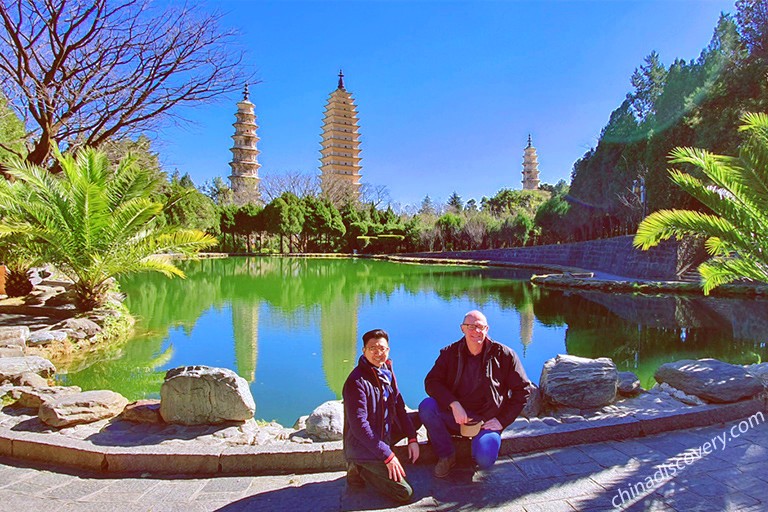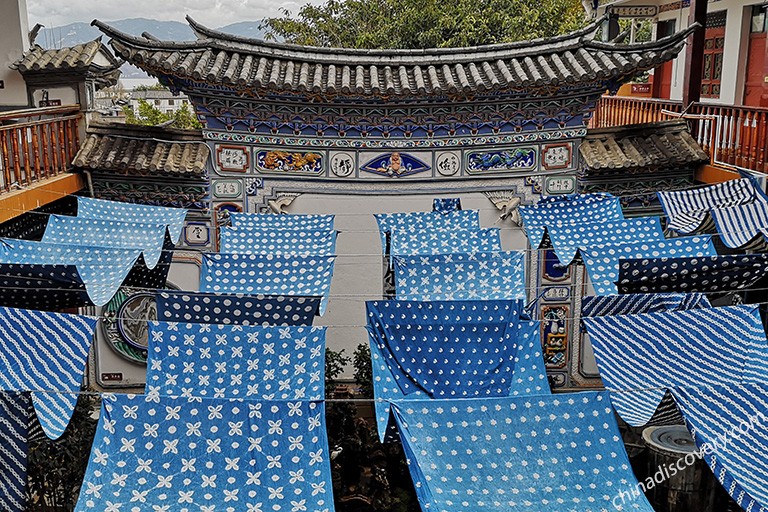Why Visiting Xizhou Village in Dali?
Xizhou Village (喜洲古镇) with a history of more than 1000 years, is located at 18 km north of Dali Old Town, west leaning on Cangshan Mountain, Erhai Lake in the east. The largest scale of Bai Residence Architectures are well-preserved here. In total, there are over 100 of Bai Residences built from Ming Dynasty which showed different eras’ characteristic.
Xizhou Ancient Town is usually served as a must-visit site in a Dali tour. It is the most concentrated place with numerous local Bai ethnic group living in. A visit to Xizhou Village, you can experience more than you can imagine - enjoy Three-Course Tea Ceremony, witness the whole process of Tie-dye and visit local morning market to see authentic daily life.
Most Popular Dali Tour to Visit Xizhou Village:
>> 3 Days Dali Highlights Tour with Bai Culture Experience
>> 3 Days Dali City Tour with Cangshan Mountain Hiking
History of Xizhou Village
Sui Dynasty and Nanzhao Kingdom - The Origin of Xizhou Village
With a history of more than thousands of years, Xizhou was first incorporated by General Shi Wansui in Sui dynasty. Soon after, the simultaneous creation of the Nanzhao Kingdom (738 - 902) and the formation of the Tea Horse Road in the 700s AD had a huge influence on the town's future. Xizhou was located only a few kilometers from the political and military capital of the Nanzhao Kingdom and benefited from the kingdom's expertise in architecture and engineering. It served as a military fortress and a temporary palace for the King on Nanzhao.
Yuan Dynasty - The Integration of Different Nationalities
The Yuan dynasty (1271 - 1368) imported a sizeable Muslim population from Northern China and Central Asia, many of the region's Muslim inhabitants can trace their ancestry back to these series of migrations. During this time, The Mongol Empire brought the region their practice of making cheese from cow's milk and whey, a tradition originating in the grassland steppes of Mongolia but one that many families in Xizhou continues today.
Ming and Qing Dynasty - the Prevail of Scholarship
During the Ming dynasty (1368 - 1644) Xizhou prospered in business and trade on the Tea Horse Road. Bai merchants traveled extensively from Southeast Asia to Tibet, trading their region's tea, marble, and handicrafts. This era brought Xizhou a scholarly reputation, beginning a tradition of writing the names of students who passed the national exam on a large gate in the town square, a tradition that continues today for Xizhou residents who have achieved success in academia, business, and politics.
After the Qing dynasty (1644 - 1912) business thrived and it became common for children of wealthy families to go abroad for their studies. Xizhou again became a center of academia, gathering professors and intellectuals after Huazhong University relocated here from Wuhan, earning the nickname "Cambridge of the East.”
Top 6 Things to Do in Xizhou Village
Even Xizhou is just a small ancient town on the west side of Erhai Lake, it’s still quiet worthy to pay a visit. In Xizhou Village, you will have a chance to see a hundreds of historical Bai residential buildings built in different eras, try famous local dishes - Xizhou Baba while wandering around Sifang Street - the center of Xizhou. When you are tired, you can rest under the shadow of Grand Green Tree where is the “Colony” for Egret. Three experiential activities you can’t miss here are the morning fair, the Three-course Tea and handmade Tie-dye.
Top 1: Join Morning Market in Xizhou and Blend in Local Life
Xizhou's daily morning market is one of the largest in the Dali valley and draws farmers and vendors from nearby villages. Tourists can spend a charming morning roaming the nearby produce market, a literal bazaar of fresh vegetables, tropical fruits, live chickens, dried spices, and vendors pressing pomegranates into fresh juice and rapeseed into cooking oil. You can try to communicate, bargaining and purchasing goods at the morning market as locals. Stroll to the lively morning market, you can learn more about the lifestyle of local people, it’s a perfect way to start a vigorous day.
▶ Learn more about Top 8 Ethnic Local Markets in Yunnan
Top 2: Appreciate the Bai Minority Residence Architecture
The folk building complex is classic, elegant and magnificent style, which is not only the symbol of Xizhou, but also the soul and treasure of Bai culture. Houses in Xizhou are of the typical Bai design known as "Sanfang Yizhaobi" with a courtyard rooms on three sides and a screen wall on the remaining side. The houses of local residents are characterized by a traditional Chinese rectangular courtyard with a screen wall facing the gate. On the screen wall there are usually four Chinese characters, reading "Qingbai Shijia" (innocent family) or "Ziqi Donglai" (Auspicious air comes from the East). Around them are landscape paintings and decorations with profusion of colors. The doors and windows are full of etchings with auspicious paintings. Bai people's architecture merges harmoniously into nature, fully embodying Bai people's aesthetic tastes of elegant, quiet, exquisite and peaceful.
Yan Family Compound (严家大院), Yang Family Compound (杨家大院) and Mansion of General Yin (尹辅成府) are typical Bai residences display the high artistic and architecture skills of Bai people.
Top 3: Try Three-course Tea and Savor the Various Life Phenomenons
The genius Three-course tea ceremony is a must try thing in Xizhou. Three-course tea, first cup is bitter, second cap is sweet and the third cup is for aftertaste, which indicating the pursuit of perfection of personality during the whole life. In ancient times, Bai nationality used it as a blessing to the younger generation when studying, learning skills, doing business and getting married. Now Three-course tea becomes a custom for Bai people when they are welcoming the guests.
The first cup, colored as amber, has an empyreumatique smelt and tasted bitter, usually served only half a cup, guests need to gulp down without a tremor. When making the second cup of the tea, the host would add brown sugar, dairy and cinnamon in the tea pitcher, which makes the tea sweet and delicious. The ingredients of the third cup of tea include roasted tea, honey, puffed rice, dried prickly ash, walnut and water. The third cup is usually 6 to 7 percent full. This cup of tea can taste all sour, sweet, bitter and spicy which leads to endless aftertaste.
Baocheng Mansion (宝成府) and Yan Family Dwellings (严家民居) are offering tourists to experience local Bai Three-course tea ceremony.
Top 4: Visit a Local Dye House and Try to Make a Tie-dye by Yourself
In 2006, Tie-dye technique of Bai Minority in Dali, Yunnan was listed as a national intangible cultural heritage. In Xizhou, whether you are at the lively Sifang street or sauntering through a quiet alley, the side walls of the houses are always hung with tie-dye of different colors and patterns, which is beautiful and enchanting. Tie-dye can be used as a tablecloth, decoration, etc. If you are interested in the making process of tie-dye, you transfer to Zhoucheng Village - “Hometown of Bai People’s Tie-dye Art” and dye one piece of canvas by yourself.
Top 5: Wandering through Sifang Street and Experience Local Culture of Bai Minority
The center of Xizhou ancient town is Sifang street, which is a small square surrounded by local shops. Here stands a stone memorial archway built in recent years called “Wenmingfang”, the original memorial archway in this place was named “Timingfang”. It was built after several local candidates successfully passed the highest imperial examinations in the Ming dynasty. At that time, all the villagers who had achieved success in the imperial examinations could engrave their name on the stone. Nowadays, there are many people resting and enjoy their food under the archway.
From Wenmingfang (文明坊), four streets radiate out. The town is not big, wandering through the main roads only takes half a day. However if you want to explore more local valleys, it would take more times.
Top 6: Try Famous Local Snack - Xizhou Baba
You can find the typical snack Xizhou Baba in Xizhou almost everywhere, especially in Sifang Street. The female shop owner kneaded and spread the dough, filled the stuffing quickly. The male shop owner is busy with fried the pastry on the iron pan heated by chestnuts. If you get close enough, you'll feel a fierce heat wave. There are two flavors of crisp Xizhou Baba, sweet and salt. Both flavors are crispy on the outside and soft on the inside. The sweet one is filled with rose petal jam and the salty one is filled with minced pork and scallion.
Most Popular Dali Cultural Tour to Visit Xizhou Village:
>> 7 Days Dali Lijiang Shangri-La Inspiring Tour with Ethnic Culture Seeking
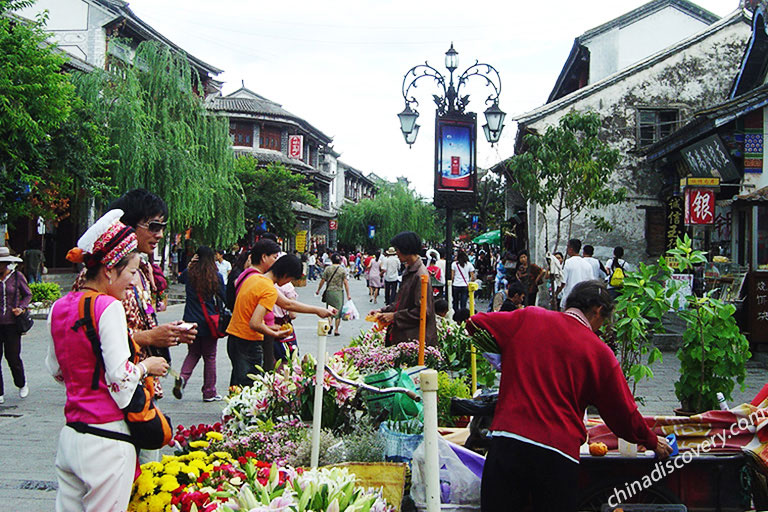 Xizhou Morning Market
Xizhou Morning Market
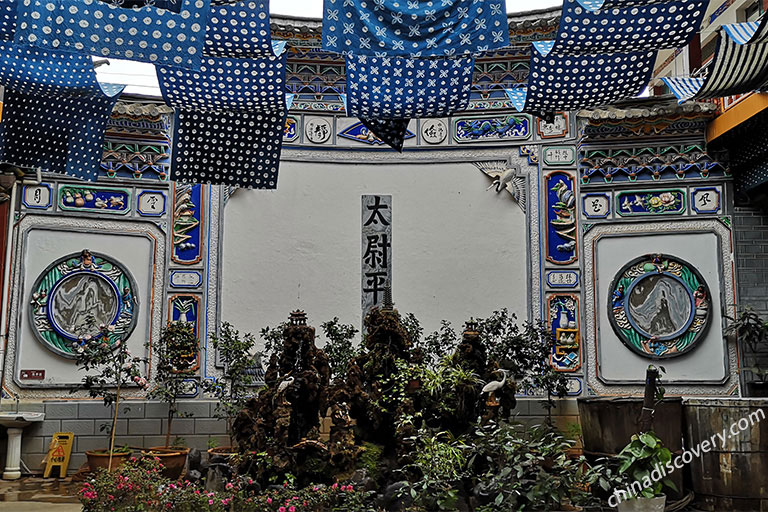 Bai Residence Architecture
Bai Residence Architecture
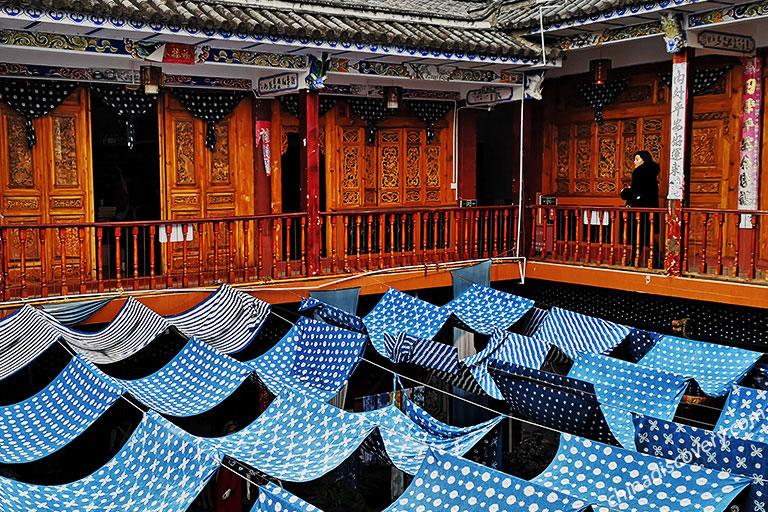 Bai Residence Architecture
Bai Residence Architecture
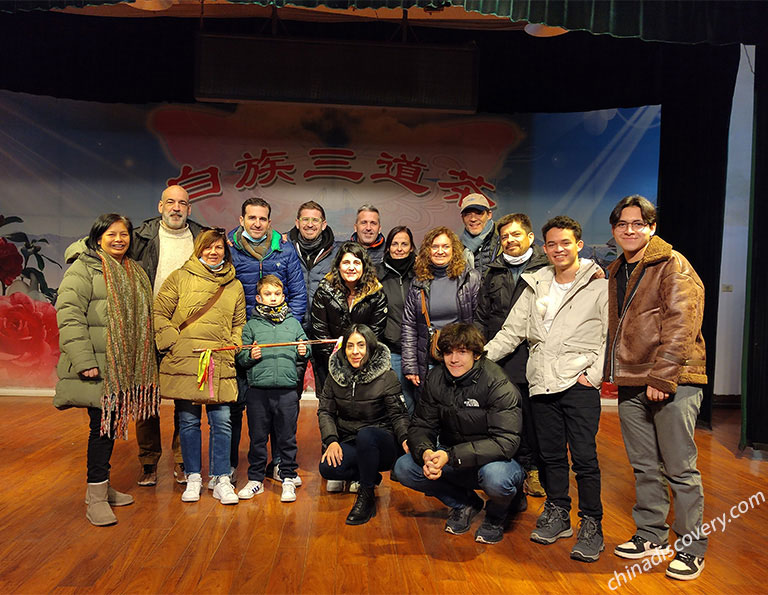 Our delighted customers feeling Three-Course Tea
Our delighted customers feeling Three-Course Tea
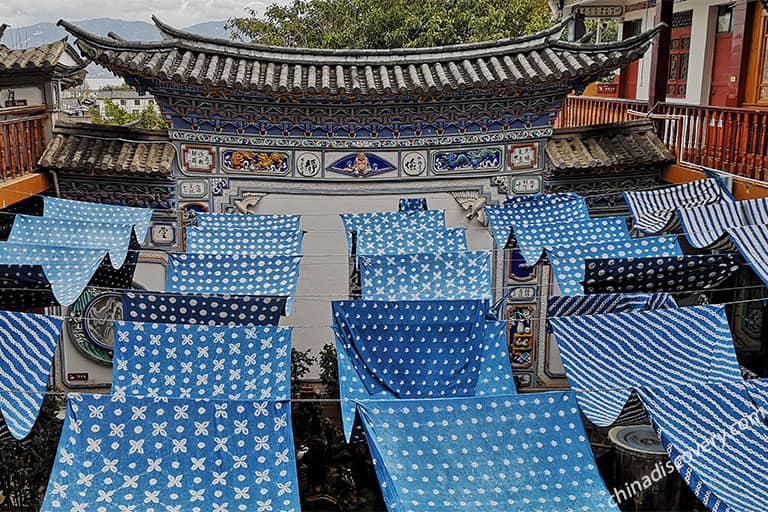 Tie-dye
Tie-dye
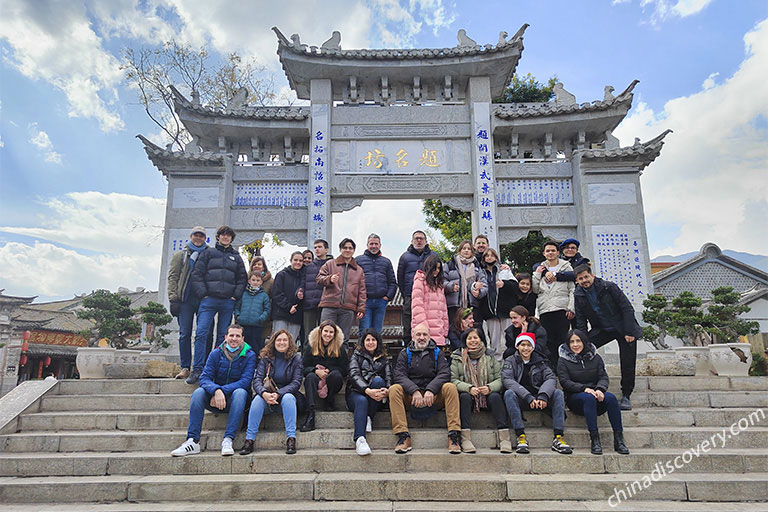 Xizhou Sifangjie
Xizhou Sifangjie
 Xizhou Baba
Xizhou Baba
Attractions Nearby Xizhou Village
Zhoucheng Village (周城)
Located 7km north of Dali Xizhou Ancient Town, Zhoucheng Village is close to the Butterfly Spring Scenic Area and is an ancient Bai village. Now entering the ancient village, you can still see the Bai people's architecture, ancient stage, Longquan Temple, Patron God Monastery and the aunts wearing national costumes. The ethnic style is strong. The art of tie dyeing is very famous, and it is the primary reason why many tourists come here. A long strip of canvas flutters in the antique courtyard, which is beautiful.
Taoyuan Village (桃源村)
Taoyuan Village is only 2km from Zhoucheng Village, it faces Erhai Lake, across from Shuanglang, and behind it is the Cangshan mountain range. It is an ideal spot for viewing sunrise. The houses in the village all follow the traditional "Sanfang Yizhaobi" architecture of the Bai ethnic group. Taoyuan Wharf is 800m from Taoyuan Village, which is a ferry to Shuanglang (双廊) by boat, this Wharf also offers the Erhai Lake boat tour.
Dali Ancient Town (大理古城)
Located at the foot of the beautiful Cangshan, Dali Old Town is the capital of ancient Nanzhao and Dali countries. With a slow pace lifestyle, a relatively warm climate and beautiful natural surroundings, it is a very conducive place for living. Combing the ancient city for artsy shops and hipster cafes is a very therapeutic and thrilling experience. The third and fourth month of the lunar calendar is filled with a lot of local festivals. The famous San Yue Jie or "Third Month Street", is the biggest festival of the year for local Bai people. Merchants come from far and wide to set up street markets and sell their interesting array of goods. There's also horse racing, archery and other competitions throughout the day.
 Tie-dye from Zhoucheng Village
Tie-dye from Zhoucheng Village
 Taoyuan Port
Taoyuan Port
Where is Xizhou Village & How to Get There
Xizhou Village is located 18km in the north of Dali City, west of Cangshan Mountain and east of Erhai Lake. You can choose bus, taxi, which are very convenient. It costs 30 minutes by car.
Travel with China Discovery
If you want to get rid of hustle of public transportation and troublesome navigation, you can travel with us China Discovery. Our local tour guide and driver will escort you to Xizhou Village from your hotel or any other places in Dali with speed, convenience and safety by the comfortable licensed private vehicle, provide you the best travel experience and take care of all the details. You just need to focus on sightseeing. Please tell us directly if you need any help!
For Independent Travel
By Car
Hiring a minivan or taxi in Dali will likely cost around CNY 40 one way. If you're planning on only stopping by for a day, there are plenty of bus, car and motor trike options in Xizhou that can get you back to Dali.
By Bus
Xizhou is a short bus ride from Dali's old town, accessible by buses from both the 214 highway and the Dali-Lijiang road (大丽路). Buses from old town should take about 30 minutes and cost around 7 RMB.
By Bicycles
There is also a scenic unsurfaced lakeside path from Caicun Pier downhill from Dali along Erhai Lake's west coast up to Xizhou. The rough surface makes it the slowest road to Xizhou but if you're willing to sacrifice speed, you can enjoy some nice lakeside scenery. It takes about 2 hours riding to get to Xizhou Ancient Town from Dali Ancient City.
 Private Car Service
Private Car Service
Transportation in Xizhou
Xizhou is a small town, visitors can walk through the village within an hour. Horse carts and bicycles are also popular modes of transportation in Xizhou.
Useful Tips for Traveling Xizhou Village
1. Raosanling Festival
Raosanling (绕三灵) is the most important religious festival in the calendar of the Bai people. It takes place in three villages in the Dali valley during the fourth lunar month and lasts for three days, each major activity taking place at a different location. The second day's activity takes place in Xizhou. The action moves to a smaller temple near the waterfront in a small village east of Xizhou. Focus of the day is on singing and entertainment, with many groups performing Bai opera - particularly later in the afternoon in the school-yard not far from Shengyuan temple.
2. Accommodation
The two most beautiful boutique hotels in the Dali region are located in Xizhou, namely the Linden Center (林登喜苑) and the Sky Valley Boutique Hotel (天谷精品酒店). Linden Center used to be the Old Yang Family Compound and originally owned by Yang Pinxiang, one of the big families in Xizhou. This boutique hotel and cultural retreat is named after Brian and Jeanee Linden, an American couple that has been coming to China for decades. Today the Linden Centre is not only a top-ranked hotel, it is also a venue for cultural exchange and an ideal jumpoff point for exploration of Xizhou and destinations further afield around Dali prefecture. Check more about Recommended Dali Accommodation | Where to Stay in Dali
3. Weather and Climate
Xizhou has a mild subtropical highland climate with short, mild, dry winters and warm, rainy summers. Average temperature of the year is about 15.6 °C. Frost may occur in winter but the days still generally warm up to 15 °C or more. During summer, a majority of the days features some rainfall and daytime temperatures rise to 24 °C . The total rainfall in Xizhou is above 1,000mm a year. The least amount of rainfall occurs in December with 13mm and the most precipitation falls in August with over 200mm.
The best time to visit Xizhou Town is from March to October when springtime is in full swing and all of nature seems to be in the process of rebirth. Trees and flowers of this garden city are green and in full bloom. Before your Dali tour, check more about Dali Weather and Climate | Best Time to Visit Dali
How to Plan a Xizhou Dali Tour
Tourists who want appreciate the Bai Residence Architecture and experience local featured activities in Xizhou usually make Dali Old Town as their first stop. Visit the ancient capital of Nanzhao and Dali Kingdoms and nearby attractions such as Cangshan Mountain, Three Pagoda and Chongsheng Temple would definitely highlight your day. You can either choose to stay in Dali Old Town or Xizhou Ancient Town. Get up early to catch local morning market in Xizhou, bargaining with locals and integrate into local society. Enjoy the exquisite residential complexes, try the Three-Course Tea and Xizhou Baba. Then transfer to the “Hometown if Bai People’s Tie-dye Art” - Zhoucheng for an appreciation of Tie-dye. Later, you can tour the vast Erhai Lake by boat. If you want to spend more days in Dali, you can plan a day tour to the only surviving market along the Ancient Tea Horse Road - Shaxi Ancient Town.
Recommended Xizhou Dali & Shaxi Tour Packages:
▶ 4 Days Dali Leisure Vacation for Nature & Culture Savory (Dali / Shaxi)
▶ 6 Days Dali Lijiang Tour with Shaxi Ancient Town (Dali / Shaxi / Lijiang)
Dali, situated between Kunming and Lijiang, is well linked by flight, train or bus with Kunming and Lijiang. Before your Dali tour, you can spend 1-2 days in Kunming, visit the natural wonder - Stone Forest. Transfer to Dali and spend 2-3 days here then continue your trip to Lijiang, take 2-3 days to tour Jade Dragon Snow Mountain, Tiger Leaping Gorge, Lugu Lake etc. For those who have more time can head to the fairyland on earth - Shangri-La.
▶ Learn more about How to Plan a Trip to Dali
Recommended Dali Yunnan Tour Packages:
▶ 6 Days Yunnan Essence Tour (Kunming / Dali / Lijiang)
▶ 8 Days Classic Yunnan Tour (Kunming / Dali / Lijiang / Shangri-La)
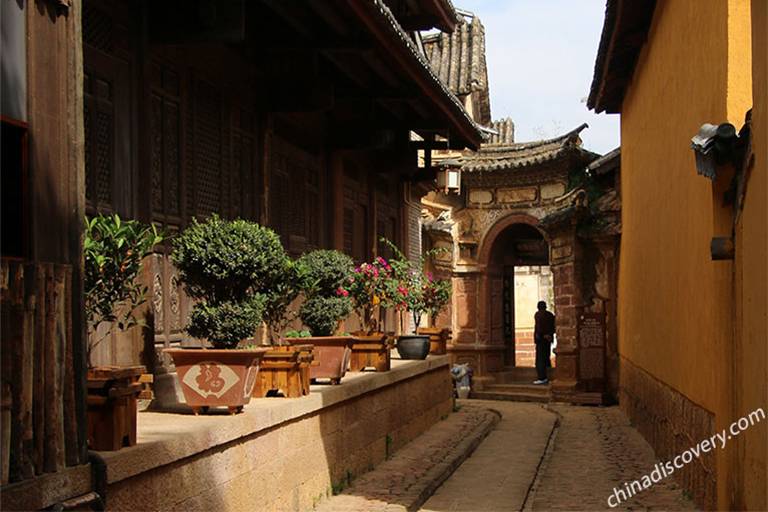 Shaxi Ancient Town
Shaxi Ancient Town
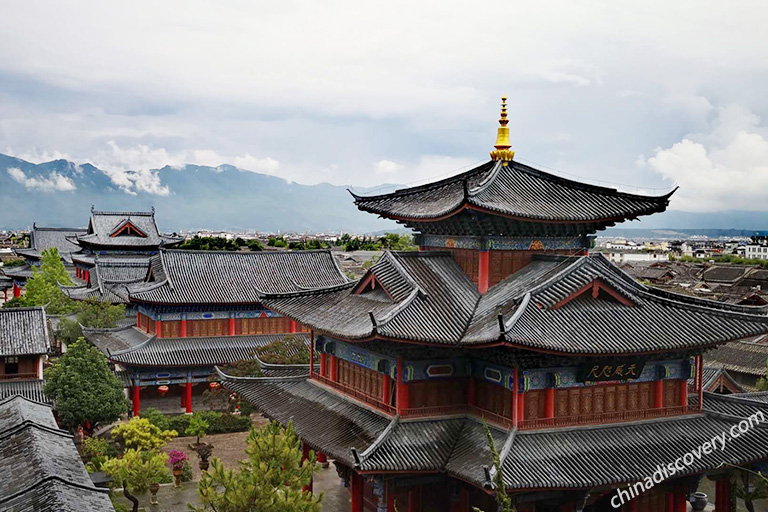 Lijiang Old Town
Lijiang Old Town
Travel Xizhou Yunnan with China Discovery
To help you enjoy a worry-free holiday in Xizhou Village, Dali and Yunnan, we highly recommended you travel with us China Discovery who is a professional about the local condition of the whole Yunnan. Our local experienced drivers will escort you to Xizhou Village or other places with comfortable car directly with speed and safety. And our English-speaking tour guide will accompany you all the way, showing you the best travelling route and introduce highlights and history of each place so you can better enjoy your historical and ethnic cultural tour in Dali, Yunnan. The tour can be tailor-made according to your group size, time, physical conditions, plan, interest, budget and every special need. If you have any other ideas about the trip or you have other places or cities wanted to visit such as Sichuan, Tibet, Guilin or Guiyang, etc. our experienced travel consultants are very glad to offer their help. Please feel free to contact us if you need any help.
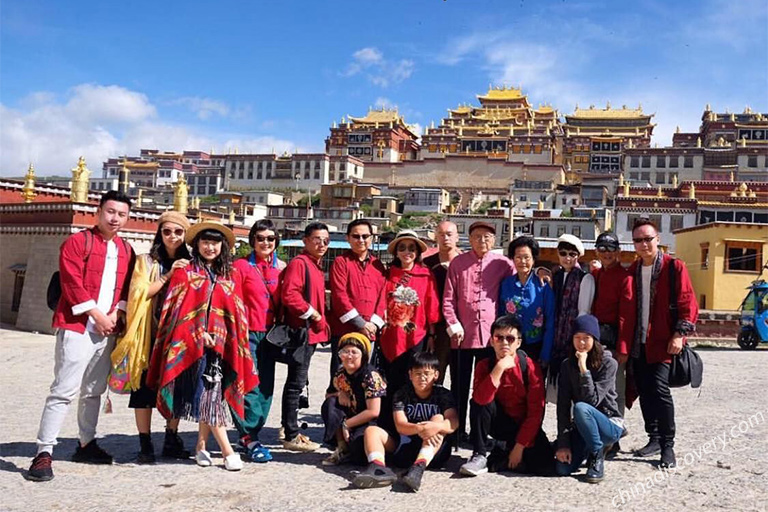 Shangri-La in Yunnan
Shangri-La in Yunnan
Keep Reading on Dali
- Dali Old Town
- Erhai Lake
- Cangshan Mountain
- Three Pagodas & Chongsheng Temple
- Shaxi Ancient Town
- How to Plan a Dali Tour
- Dali Things to Do
- Dali Attractions
- Dali Transportation
- Dali Weather
- Dali Where to Stay
- Dali Hotels
- Dali Maps
- Dali Travel Guide
- Dali Tours
Useful Yunnan Travel Articles
Recommended Dali Tours
Top 3 Dali tours chosen by most customers to explore Dali in the best way. Check the detailed itinerary, or tailor your own trip now with us.

6 Days Dali Lijiang Tour with Shaxi Ancient Town
Dali / Shaxi Ancient Town / Lijiang

7 Days Dali Lijiang Shangri-La Inspiring Tour with Ethnic Culture Seeking
Dali / Lijiang / Shangri-La
Start planning your tailor-made holiday to China by contacting one of our specialists. Once inquired, you’ll get a response within 0.5~23.5 hours.
Customize a TripHave a question? Get answers from our travel experts or guests
- Your Question:
- Your Name:
- Your Email:
- Submit



























